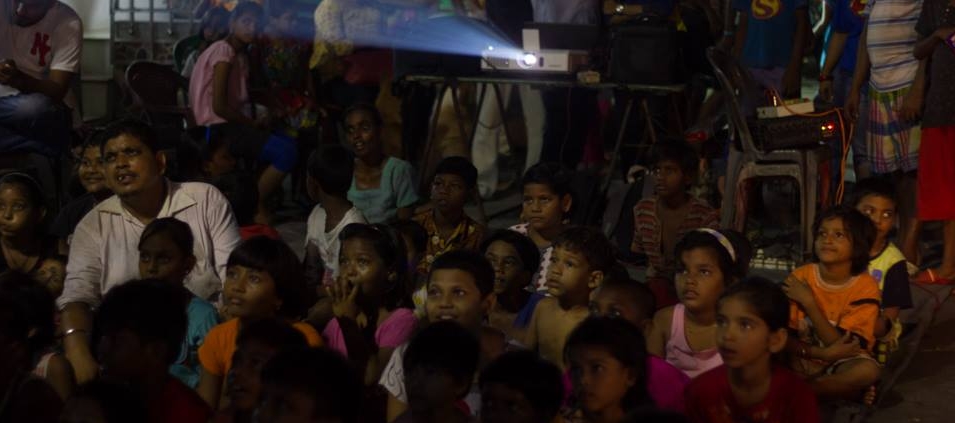Love in the time of Trishul
It was a particularly sweaty afternoon that Little Cinema had gathered at Santragachhi among a bunch of smiling little faces. An ‘auspicious’ day indeed, on the occasion of Ramnavami – the celebration of which has resulted in targeted violence all over the state where it had no cultural significance a couple of years earlier. When the far right is exercising its political power with all its might, when it is entering our everyday discussions, everyday practices seamlessly, when it is molding everything into its mold of a single Hindu Rashtra, the right to question almost becomes a luxury. It is precisely in such a situation that the Little Cinema campaign of People’s Film Collective has been trying to reach out to the young minds, attempting to engage with them differently in various parts of the state with cinema and conversations as its only weapon.
Santragachhi Sporting Club was our venue, with a very old campus of an industrial training institute and some shrines of Baba Dakshinaray – the tiger deity around. Legend has it, as some bystanders informed us, the infamous dacoits of Bengal earlier used to pray there before they ventured into the Sundarbans. However, small rallies celebrating the birth of Ram were very much happening in the vicinity. Nothing could still stop children, tentatively in the age group of 7-12 years, pouring in the play ground for the films, with their usual cacophony in full volume. Trina and Labani – our discussants for the day – started with a small clip on Charlie Chaplin and proceeded with a line-up of films from different parts of the world.
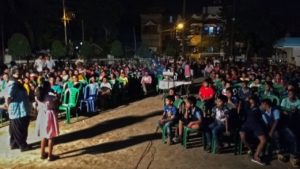
Every time we screen films in foreign languages, we find out the myriad ways they relate to the films. The Chairy Tale, for example, found particular resonance with children, everyone laughing at the beats of Ravishankar’s music and the theatrics on screen. One little comrade came up to the front and shared beautifully how the film made her feel for the non-living beings around us, how they feel too, and how all of us should be caring about that. How we all use trees, animals and never care about them after our needs are met, and yet they keep silently helping us. Later children forged connections of this film with the audio-visual rendition of Gaon Chhorab Nahi.
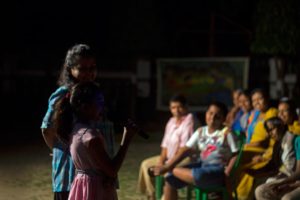
Two and Two, for example, stirred everyone in the audience and Somdatta, Sourav, Sampurna all convinced us how one should be standing up for the truth no matter what; how it is the remnants of hope that ultimately matters. One indeed falters at the escalation of the student being shot, and yet someone writes the right answer at the face of terror, and we believe these children with their glowing faces would be that hope in our future at the face of the oppressive Fascistic aggression. The Accordion captured everyone’s heart with the sheer spread of love even while you’re being affected and so did Neighbours. These vibrant minds talked in refreshing simple terms and conveyed the futility of animosity between neighbours, between classmates, friends, communities and the like – even when just a little while ago they were leaving no opportunities to annoy each other!
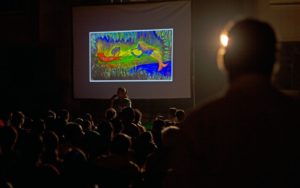
Perhaps it was an ultimatum about the fight that lies ahead, or perhaps it was an untimely reward for the chord we were able to strike that day that a Nor’wester came in and disrupted our screening. The children could only see six of the eight films that were planned, with everyone rushing around in the storm and rain to save themselves and our electronic equipments. Somehow it lacked completion, who knows what gem awaited us with the rest of the film and the rest of the kids whose insights we had to miss. However, we got the chance to chat with some organisers and fellow parents of the children who unanimously agreed that the event has been unexpectedly engaging with the children actively taking part in the discussions and responses. As we talked to some of the children they promised to write to us and draw to us.
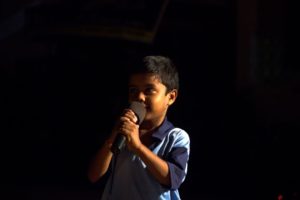
Returning from Santragachhi, after the storm, we could not forget how such young minds relate to concerns with events in their own life, how they feel strongly about things, how they demand to be treated as thinking, feeling, little people. Like the language of the accordion connects the beggar and thief with the two children, the language of cinema has the potential to affect; the task that lies ahead is to build such spaces for these minds to be able to spread their wings, collectively.

